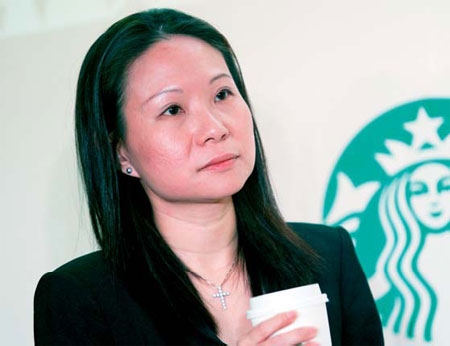Getting a shot at the coffee market
|
 Belinda Wong, Starbucks China president, says each new store will be unique in design. [Nelson Ching / Bloomberg]
|
John Culver, president of Starbucks China and Asia-Pacific, says that "as a 12-year Starbucks partner, Belinda has demonstrated exceptional leadership, strong business acumen and deep passion for the Starbucks brand and our partners".
Having opened the first store on the Chinese mainland on Jan 11, 1999, at the China World Trade Center in Beijing, Starbucks has become a part of many communities throughout China with its stores located across 42 cities.
"I am not new to China. During my 12 years with Starbucks, I spent time in the market as managing director for the company-operated markets of Starbucks China, overseeing 180 stores in China's North, Northeast, South and Southwest regions," she says.
Since moving back in May, Wong says she has been extremely humbled by the new things she learns about the market every day from Starbucks partners and customers.
Although China is a huge and diverse market, her perception of it caused her to firmly believe that the value of the Starbucks experience is relevant regardless of background, spoken local dialect or culture.
During 2010, it entered 13 new markets in China, including Wenzhou, Zhejiang province, Kunming, the capital of Yunnan province, and Hefei, capital of Anhui province.
Speaking of the ambitious expansion plan, Wong says the key to its growth strategy in China is that each Starbucks store is unique to its partners, customers and the community.
"We are not just aiming to open another 1,000 stores over the next four years. We are, in fact, opening one store 1,000 times," she says.
"Each new store will be designed in a local, customized way. It will have to engage the community where it's located instead of being alien to local people."
There are several factors that determine store locations, such as demand and real estate factors. "The store location must make business sense for the company," she says.
Wong, who was in charge of Starbucks business in Hong Kong for a long time, says there are more similarities than differences in business strategy and operations between the two markets.
She also adds that if there is one difference she can highlight, it woull be the speed of services. "Speed of services is important to our customers in Hong Kong as many of them will order their beverage to go. They come into our stores, place their orders and will want to collect their beverage quickly before rushing to their next appointment."
The biggest challenge for Starbucks' further development on the mainland is "how to make sure that we don't lose the focus in doing what we do best as well as remaining true to our brand and values", Wong says, to which she refers to as elevating the coffee experience within the market.


















